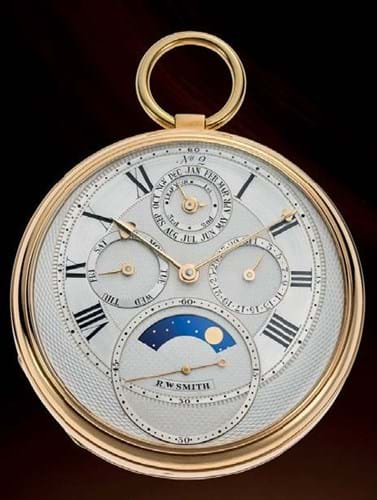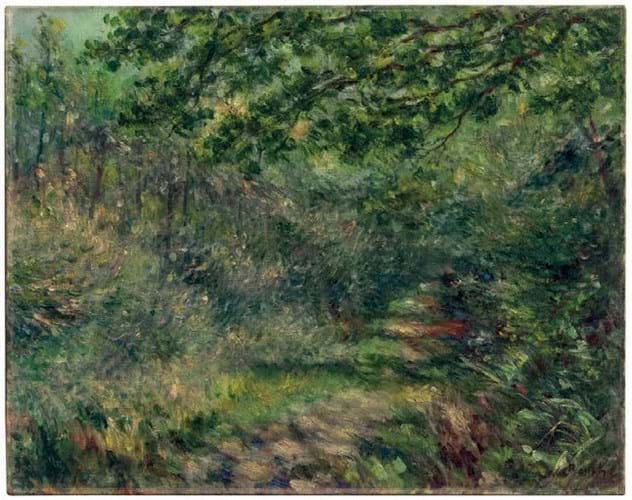
Roger Smith Pocket Watch Number Two, $4m (£3.15m), or $4.9m including buyer’s premium, at Phillips in association with Bacs & Russo.
Pocket watch sets British record
A modern pocket watch sold at Phillips in association with Bacs & Russo has set a new record at auction for any British timepiece and is the fourth-highest price ever achieved for a pocket watch at auction.
The price paid for Roger Smith Pocket Watch Number Two, a 1998 yellow gold perpetual calendar tourbillon pocket watch, by horologist Roger Smith (b.1970), is also a record for any watch by him.
It was hammered down at $4m (£3.15m), or $4.9m including buyer’s premium, at the auction on June 10-11 in New York.
Smith trained under famed horologist George Daniels (1926-2011). This pocket watch was Smith’s second attempt at making a watch from scratch to win the approval of Daniels and secure an apprenticeship in his workshop on the Isle of Man.
Pocket Watch Number Two led Daniels to proclaim to Smith: “You are now a watchmaker.” It was bought by a collector on the phone via Paul Boutros, Phillips’ head of watches Americas.
Renoir work heads to Northern Ireland
National Museums NI has bought Pierre-Auguste Renoir’s (1841-1919) L’allée au bois via the government’s Acceptance in Lieu scheme for the Ulster Museum.
The scheme, which is administered by the Arts Council, allows for the ownership of works of art to be transferred to the nation in lieu of inheritance tax.
In this case it is from the estate of Sheran, Lady Hornby, in memory of her uncle, Major Victor Cazalet (1896-1943). It settles tax of £1.46m. Christie’s Heritage Advisory Service assisted in the acquisition.
Painted in a wood near Paris c.1874-80, L’allée au bois is an example of Renoir’s skill as a landscape painter.
Helen Birchenough, chair of the Acceptance in Lieu Panel, said the painting was acquired in a hybrid agreement with funding from the Department for Communities (for Northern Ireland), the Art Fund, The Esmé Mitchell Trust and the Friends of Ulster Museum.
Biddle & Webb ceases trading
Birmingham auction house Biddle & Webb has ceased trading. In its telephone answering message it said: “Biddell & Webb will not be holding future sales and we thank you for your past custom.”
Consignors and buyers with items to collect should contact the firm by email. According to the firm’s website, accountancy company Mazars is assisting in the situation and financial questions regarding Biddle & Webb should be sent to liam.flavell@mazars.co.uk.
Klimt estimate is a European high
One of only a small number of portraits by Gustav Klimt (1862-1918) still in private hands will be offered at Sotheby’s in London this summer.
Dame mit Fächer (Lady with a Fan) was the last portrait Klimt painted and was still standing on an easel in his studio in Vienna at the time of his death (he died after suffering a stroke and catching pneumonia).
It will be offered at Sotheby’s Modern and Contemporary evening auction on June 27 with an estimate in the region of £65m, the highest pitch for any painting ever offered in Europe.
Originally owned by Viennese industrialist Erwin Böhler, whose family were close friends and patrons of both Klimt and Egon Schiele, the work was last on the market nearly 30 years ago when it sold at Sotheby’s New York for $10.6m (£7.1m) in 1994. The buyer back then was a member of the current owner’s family.
Most read
The most clicked-on stories for week June 8-14 on antiquestradegazette.com
1 Second Gonsalvus portrait now emerges
2 Private bidders go sleeper spotting
3 Rare print of an early British tennis tournament stars in our pick of five auction highlights
4 Rolex taken from £200 original purchase to £45,500 at auction
5 Doulton Lambeth bear model is among five lots to watch
In Numbers
482
The number of metres (according to Google Maps) from ATG’s office in Southwark to a newly discovered Roman mausoleum. The Museum of London Archaeology, which led the dig, believes the quality of preservation makes it the most intact Roman mausoleum ever to be discovered in Britain.















